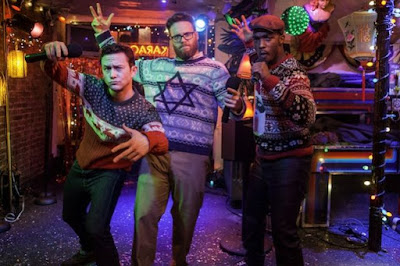Now playing at a multiplex near you:
CREED (Dir. Ryan Coogler, 2015)
Over at the movie website ScreenCrush, critic Matt Singer coins a term that I really hope catches on: “legacyquel.” Singer writes that it describes a “very specific kind of sequel - in which beloved aging stars reprise classic roles and pass the torch to younger successors.”
The phrase fits, especially when applied to the highly anticipated seventh chapter in the STAR WARS saga, STAR WARS: THE FORCE AWAKENS (out in 2 weeks!), but it’s the seventh installment of the Rocky franchise, CREED, that really embodies what a great legacyquel should be all about. And it’s largely because it features an Oscar caliber supporting turn by the series’ star.
On the surface, CREED is a spin-off centered on Michael B. Jordan as Adonis “Donnie” Johnson Creed, the son of Rocky’s greatest opponent, world heavyweight champion Apollo Creed, and it works as such for its first 20 or so minutes.
Donnie’s back story is that he was born to a mistress of Apollo’s who later died leaving him to bounce from foster homes and juvenile detention, until his adoption by Apollo's widow Mary Anne (Phylicia Rashad). Donnie’s adopted mother worries about his fighting lineage, hoping that he’ll take a job in a corporate office instead of pursuing professional boxing, but she knows he’s his father’s son and there’s no getting in the way of his dream.
That’s where Sylvester Stallone, resurrecting Rocky Balboa from the ashes of what was supposed to be his swansong (2006's ROCKY BALBOA), comes into play. Donnie travels to Philadelphia to coax the Italian Stallion out of retirement to be his trainer, but Rocky, still running the restaurant established in the last sequel (ROCKY BALBOA), tells him that he “don’t do that stuff no more.”
You know it’s only a matter of time before Rocky gives in and we’re immersed in training montages of Donnie, in a familiar gray sweatsuit, intensely working out at the gym, running through the streets of Philly at dawn, and chasing chickens, all set to the triumphant score of Swedish composer Ludwig Göransson, which, of course, calls upon Bill Conti’s iconic Rocky theme “Gonna Fly Now” at just the right moments.
Stallone’s Rocky now takes on the part that Burgess Meredith’s Mikey played in the first three films in the series, that of the lead’s trainer/father figure, and he wears it well. The duo attempt to keep their collaboration under wraps, but after his first major fight with the gym owner’s (Richie Coster) son (Gabe Rosado) it gets out that Donnie is Apollo Creed’s offspring.
This leads to Graham McTavish as the manager of “Pretty” Ricky Conlan (played by real-life professional boxer Tony Bellew), setting up a fight between his client and Donnie. The highly hyped event will be the last professional match for Conlan as he is going to jail for seven years for gun possession, and it will serve as this entry’s trademark final fight.
Meanwhile, Donnie has a love interest on the side in the form of his neighbor Bianca (Tessa Thompson, DEAR WHITE PEOPLE, SELMA), it turns out that Rocky has Non-Hodgkins Lymphoma but refuses to undergo chemotherapy because of what his late wife Adrian went through. This moment, in which Rocky faces his mortality in a cold hospital room, is one of the film’s most affecting. Stallone’s performance is a thoughtful and measured piece of work that deserves all the Oscar buzz its getting.
It’s also uplifting and exciting to witness the making of a bonafide movie star. Jordan bests his solid work in Coogler’s stirring 2013 debut FRUITVALE STATION, his first collaboration with screenwriter/director Coogler, and should really make a name for himself with his powerfully invested work here.
Jordan obviously did a lot of real training for the gripping and emotionally wrenching fight scenes, which were shot by cinematographer Maryse Alberti. Donnie’s first fight is a standout scene: a single, long unbroken shot taking place inside the ring, captured by stunningly choreographed camerawork.
In the incredible CREED, Coogler punches up the Rocky formula with great success. It believes so deeply in the Rocky mythos, that we believe in it too. We go along that these are real people with a shared history because every detail, from Rocky and Donnie’s interactions to the tidbits revealed about the past, is convincingly heartfelt. CREED keeps it real, while keeping all the Rocky feels.
It’s truly one of the biggest surprises of the year that CREED is as genuinely good as it is. It’s the must see movie event that few saw coming, and it’s, for sure, the legacyquel this season to beat. However, I hear that the Force is strong with its upcoming competitor.
More later...











